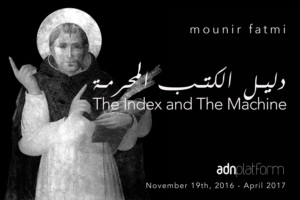The Index and the Machine

ADN Galeria, 11/19/2016 - 04/01/2017
Avda. Can Roquetas esquina Victor Hugo 08173 Sant Cugat del Vallès
ADN Galeria presents the second solo show by mounir fatmi at ADN Platform: The Index and the Machine. The Index and the Machine is a word association used in Western history for a long time, at least since the Renaissance, the period in which the printing machine originated and the first Index (the list of prohibited books by the Church) was published.
The printing machine changed writing, literature and especially culture in all its aspects. Until its creation, some instruments and tools had allowed a controlled circulation of religious ideas. Nevertheless, it wasn’t until its creation that books experienced a massive diffusion. As an instrument devoted to democracy, it quickly became a vehicle for the expansion of multiple ideas. However, the accession of the printing machine also brought censorship and ideological control to its peak. A proof of this was the first published text, the Bible, which served as a model but also an imposition that shaded the spread and evolution of more advanced theories. Since then, the Church published normative texts such as the List of Prohibited Books (Index librorum prohibitorum), which wasn’t formally abolished until 1966. Throughout these four centuries, a vast amount of philosophers, authors and writers were “mis à l’index”¹, and their works were accused of being ‘pernicious’ by the Catholic Church.
All these problematics linked to this paradoxical duality, carried by the mechanization of an ancestral technique as writing is, are the basis of the individual exhibition of mounir fatmi at ADN Platform. Through the video work Le Silence de St Pierre Martyr, the artist offers an analysis of intercultural relations confronted with prohibition and censorship. Fatmi’s questioning stance towards religion sets a series of interrogations about what is common and established, always from a respectful and thorough position. In Le Silence de St Pierre Martyr, fatmi transforms Fra Angelico’s “Saint Peter Martyr Enjoins Silence” (1441-1443) in a digital animation. By doing so, the artist destabilizes its meaning and evokes the violence hidden under the absence of words.
On the other hand, the piece Qui est Joseph Anton? confronts directly the consequences carried by literary censorship, as experienced by writer Salman Rushdie in 1989. Rushdie, who was forced to hide after Ayatollah Khomeini’s fatwa in Iran, forged a new identity under the alias of Joseph Anton by taking two of his favorite writers’ names: Joseph Conrad and Anton Chekhov. Fatmi’s piece “Who is Joseph Anton?” takes Rushdie’s endurance to investigate the notion and assumption of identity, as well as its fluidity and the malleability of the term. On the other hand, the project looks into the notion of alterity in literature and philosophy, and the boundaries between the self and the other.
Beyond the artworks on censorship, mounir fatmi seeks to interpellate the viewer regarding the concept of culture and history through the project Le Jongleur. By taking the opposite idea of the Index, seen here as a reflection of “universalist” culture that has prevailed during four centuries in the Catholic West, the artist disrupts the notion of History and European humanism. As the printing machine both channeled the circulation of ideas and censorship, the image of Le Jongleur allows the artist to address critically the antinomic consequences carried by progress.
Finally, “Le Paradoxe” is a new production through which fatmi investigates the limits of interpretation. The sculpture shows an obsolete grinder (a machine used to sharpen). Pieces of Arabic calligraphy surround the machine: the pieces seem to be extracted from a circular sawing sheet that is also a component of the grinder. The Arab writing, entity of any previous evidence to the Koran revelation, has been separated from the machine.
The religious text has become finally an abstraction that impedes the dogmatic message and allows for an open interpretation. By sharpening and cutting the language, Le Paradoxe lifts the weight of the religious message. It also allows for the recovery of a critical spirit that does not associate meanings to a sole concept. By taking the saw that cuts the words as a metaphor, the artwork contrasts the ancestral process of writing to modern technology, the infinite verb and its fragility. Ultimately, it evidences the instability of the meaning of language.
Through these works, the exhibition The Index and The Machine proposes a deep examination of certain topics to which fatmi tries to respond -such as the effects of hegemonic discourses, history, interpretation, memory and identity. Those topics are also present over the whole of his artistic production.
For More Information